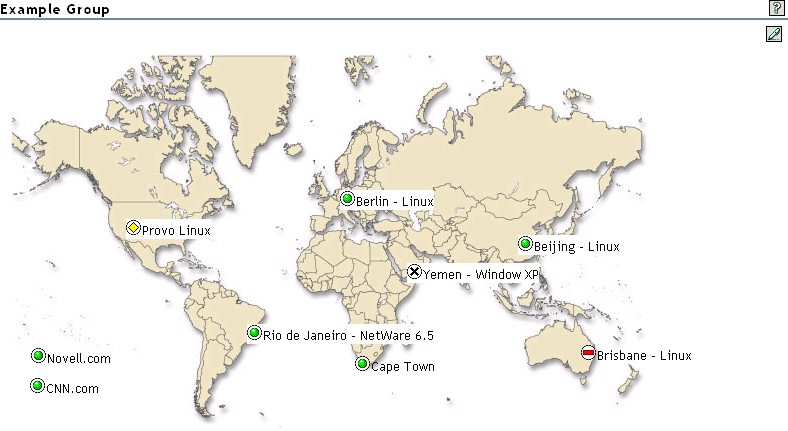11.0 Using Groups and Group Operations
Novell® Remote Manager lets you build and use server groups and perform similar operations on them or run reports to collect data from multiple servers.
This section includes instructions for accomplishing the following tasks:
NOTE:In previous version of Novell Remote Manager, part of this functionality was in the Use Server Groups category.
The following figure shows a group created to monitor servers throughout the world. These servers show various statuses. From this group, you can not only monitor server health, ping, and printer health statuses but perform various operations and run reports on this server group.
Figure 11-1 Example Server Group


You can perform the following tasks on servers that are running the NetWare® 6.5 version of Novell Remote Manager:
-
Add additional monitor items such as:
-
The ability to ping a remote server or download a Web page.
-
Monitor iPrint (if configured)
-
Monitor Branch office servers (if configured)
-
View the response activity of designated TCP/IP services
-
-
Add specific labels to the monitoring items or groups of items, and change the color of the label and its background.
-
Search Novell eDirectory™ for and add objects that can be monitored, such as Web servers, print managers, GroupWise® domains or post offices.
-
Display status only when it is not normal (good).
-
Synchronize the following information between servers (group operations):
-
Sadmin user password
-
Sdbug user password
-
Changes to the default eDirectory context for users logging into Novell Remote Manager
-
E-mail setting for the mail notification page
-
Health item threshold settings
-
Health item configuration settings
-
-
Run reports to compare the following on servers in the group:
-
Set parameters
-
Modules running on each server
-
Server up times
-
Storage space, size, usage, and so on.
-
-
Group servers into collections and monitor or manage the collection.
-
Access the server in the group and do the following:
-
Access the Administration page for the server.
-
Monitor server health for the server
-
Access the Novell Remote Manager page for the server
-
Change the item that is being monitored
-
Delete the server from the group.
-
Using this feature involves performing one or more of the following tasks:
-
(Optional) Saving a Group.
You only need to perform this step if you want to use the group at a later time.
-
Performing Synchronizing Operations on Server Groups or Generating and Viewing Server Comparison Reports.
The monitoring operations start immediately. Other tasks such as performing operations or running reports require additional steps.
-
(Conditional) Accessing an Existing Group.